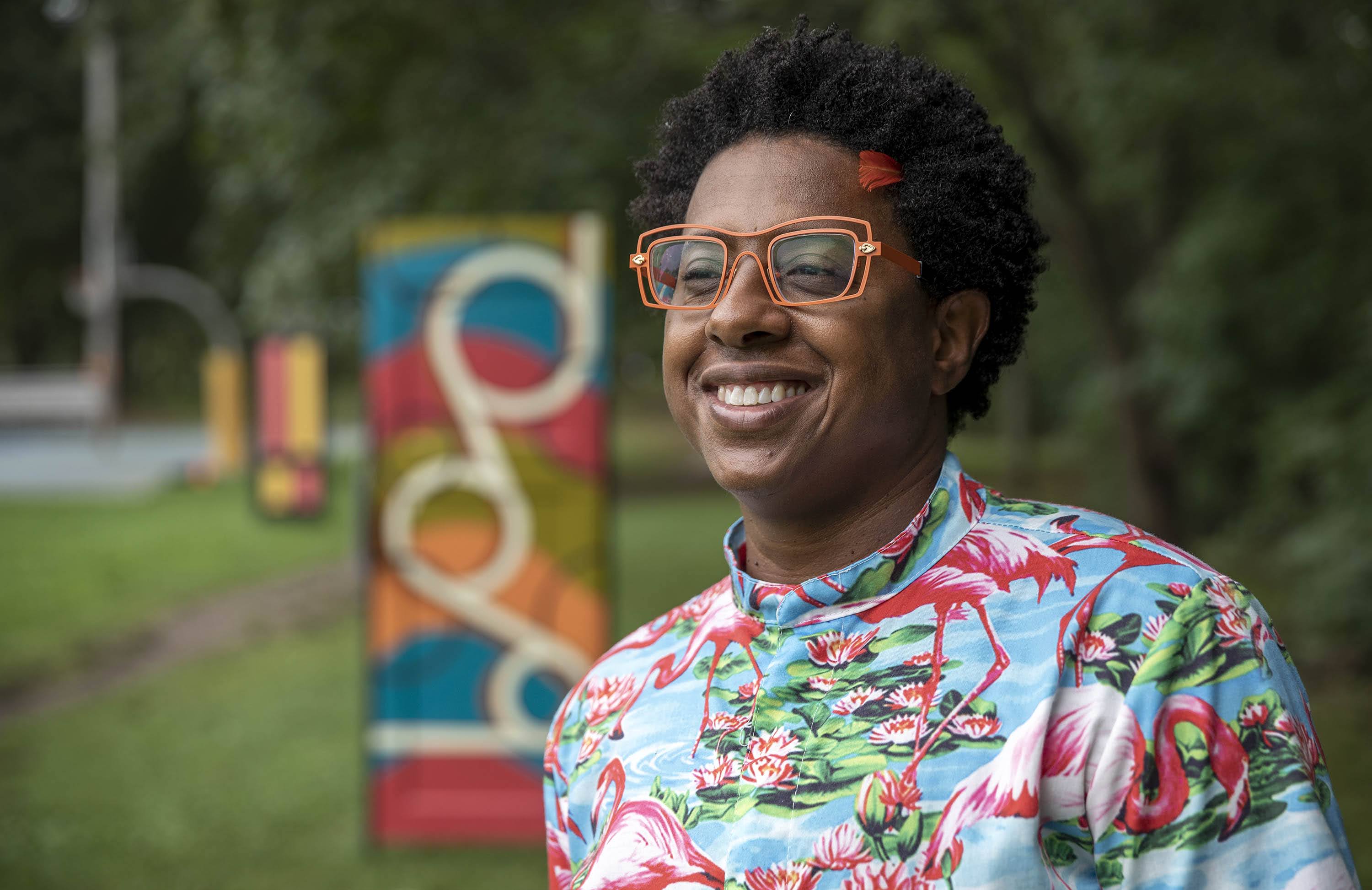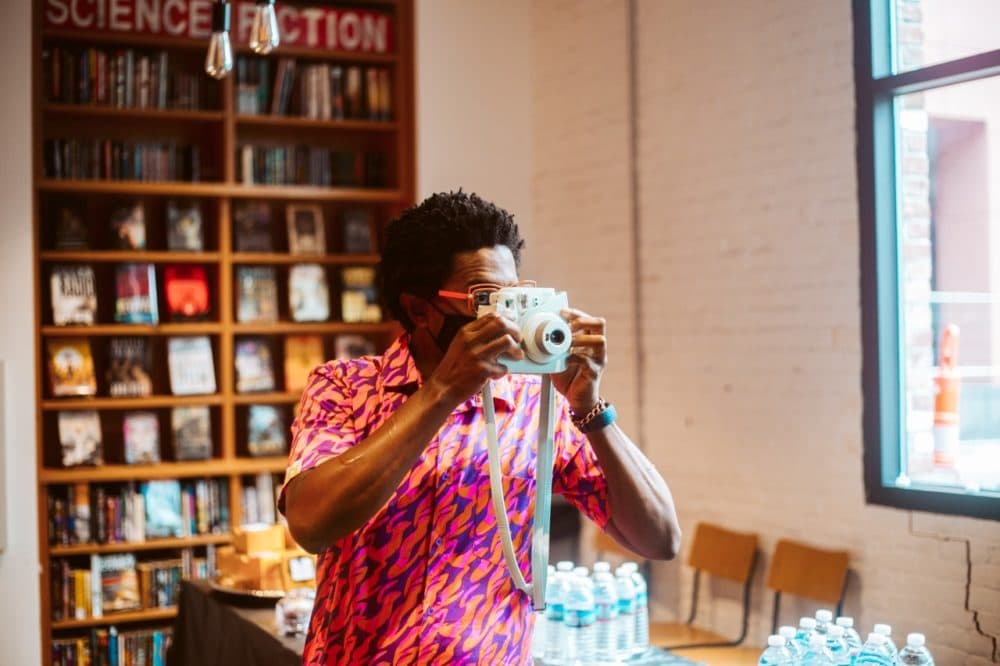
Artist Bashezo Uplifts People In The Queer And Trans Community
Words were never sufficient for bashezo, so they began working with their hands. Gender was limiting, so they found new ways to express their identity beyond the strictures of the binary.
“I would say [I] felt really contained and confined, felt alien in my own house, in my own body, in my own life,” bashezo says about how they felt as a young person. “I think that that's why the creative work and the work with my hands became so important.”
The ARTery's weekly newsletter is your essential connection to Boston's arts and culture scene. Sign up here.
This trans nonbinary artist has spent nearly half a lifetime defining who they are, finding solace in spirituality, sculpture and building art installations. They’ve had many names. They’ve lived in many places. They laugh when I ask them how many times they’ve come out. At nearly 50 years old, they’ve shed so many layers already, and yet, they continue making new discoveries.
“It's been amazing to be in conversation with so many young Black trans folks who, at 20, are able to articulate and be with themselves in ways that I yearned for and longed for, but didn’t have the vocabulary, didn't have a community, didn't have the support for,” bashezo says. “I was moving and working my way to that, kind of blindly, and falling off lots of cliffs.”
There’s a saying in the trans community: "to give them their roses while they’re here." This was the heart of their most recent effort — creating altars for a project called Roots + Futures.
"Our lives and our experiences are so important. And it's important that they're told with nuance and with honesty and with love and with care and not extractive."
bashezo
Alongside a cohort of queer and trans creatives known as the Unbound Bodies Collective, and in collaboration with community members, they’ve spent several weeks installing these intricate altars, each one unique. One photo shoot on a beach for a living alter portrayed a trans woman like an ocean goddess rising from the sea. Around her are syringes of estrogen and other personal items she chose to portray her transition and growth.
“Our lives and our experiences are so important,” bashezo says. “And it's important that they're told with nuance and with honesty and with love and with care and not extractive.”
On a recent Saturday in Dorchester, bashezo softly tears petals off white roses adding them to a fragrant concoction — almond oil, almond syrup, rose water, rain water, snow water. “This is for folks to clean themselves when they leave the graveyard, they say, "just to make sure no one has hitched a ride and so that they feel nice and light afterwards.”
Advertisement
It’s an afternoon of preparation for the artist and Lucumí priest, an African diasporic religion that venerates the ancestors. This day, they’re creating a ritual to honor the living and the dead, a procession that will pay tribute to three enslaved persons buried long ago as well as uplift Black queer artist Ife Franklin. They place offerings at the Dorchester North Burying Ground: fresh eggplants, plums, honey and cigars.
Marigolds surround bashezo and Franklin as they talk about what this day means to them. The flower’s scent and color is said to lure souls back to the land of the living.
“This particular project is so dear to me because I get to honor my Black self with Black queer people running the show because Black queer people love our ancestors,” Franklin says. “In many cultures, the queer folk are the two-spirited folk. The queer folk are the gatekeepers, the queer folk are the magic people.”
bashezo agrees.
“There’s a need right here for many U.S. Black folks to remember and to connect with our ancestors as much and in as many ways as possible,” bashezo says.
Franklin leads the procession that evening.
The group gathers at sunset, dressed in all white. They hold white umbrellas aloft, some scatter marigold blossoms along the sidewalk. Some hold incense, singing along.
bashezo listens, watchful, making sure everyone has what they need. Water. Support.
They’ve always felt different. As a child in South Philadelphia, they constructed sculptures out of popsicle sticks or tinfoil. A day earlier, they told me how they grew up, surrounded by intense love, coupled with intense trauma. Their mother was in and out of the hospital as a result of a terminal illness. She outlived the prognosis by three decades. She wanted the best for her child, but had her own idea of what that liberation looked like. bashezo remembers needing to overcome this internalized belief: that someone poor and Black couldn’t be an artist.
“I wouldn’t say anything in my life feels cohesive,” they say. “It feels like a series of spirals and fragments...There was a lot of anger and that took years to reconcile to put in the proper place.”

They first left home at 14, dropping out of high school to live on their own or squat with a bunch of anarchists and communists in West Philly.
“I think that was the time when things really started to shift, but with a lot of friction and a lot of conflict and a lot of hurt,” they say. “My mom did a lot to try to give me a better life. And those decisions felt like I was s----ing on all the sacrifice she made for me. That took us some time to work and move through.”
Within a few years of leaving, bashezo and their mother made their peace, building a healthy relationship and showing their true selves to each other. She called them by their self-determined name. They found practical work as an apprentice in carpentry, tile work and construction, which led the way to working with wood, mosaic and clay. They found performance art, a medium which paved the path to seeing their body as a tool.
“And I knew that there were things here inside that needed to move and needed to transform,” bashezo says. “And that all felt very spiritual and that all felt really guided by my ancestors.”
This intermingling of the artistic and the spiritual was ever present during the procession in Dorchester. Drummers waited at the cemetery gates, producing rhythms to allow passage into the grounds. Candles and flowers are placed at the worn headstones of three enslaved people: Ann, Cambridge and Betty. Franklin invites attendees to shout out the name of an ancestor.
Audre Lorde. Toni Morrison. Family names. The name of friends.
"...There was another way for me to be in this body, in this world, in this life, and that it wasn't going to look like anything...that I'd seen before, especially not my family."
bashezo
A woman’s voice rises and falls in song as she beckons goodness and blessings into the space.
bashezo places rosewater on their sternum, the back of their neck, and shakes the excess off to keep the spirits at bay. Smiling under their mask, bashezo thanks the group for acknowledging these lives, past and present. They used to believe they wouldn’t live past the age of 25. They struggled to imagine a place where they would fit.
“I think in the recognizing of what I wasn't, the dreaming and the conjuring began, however slow it might have been or slowed down by trauma and harm and violence,” bashezo says. “That there were other options and that there was another way for me to be in this body, in this world, in this life, and that it wasn't going to look like anything...that I'd seen before, especially not my family.”
Now, they manifest worlds, call into being that which they once needed, honoring both their ancestors and those generations to come.
